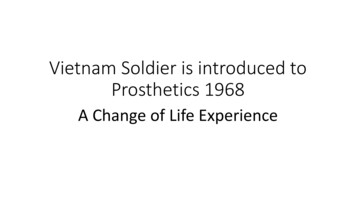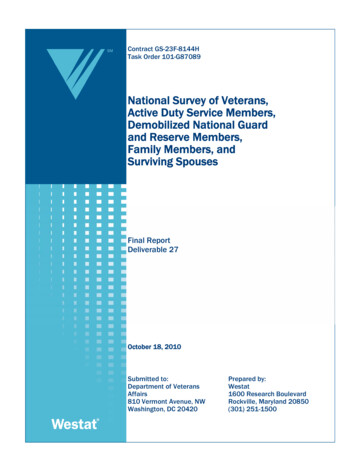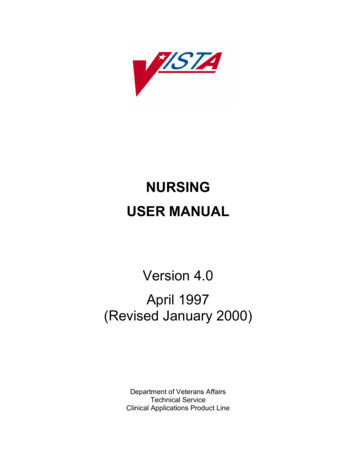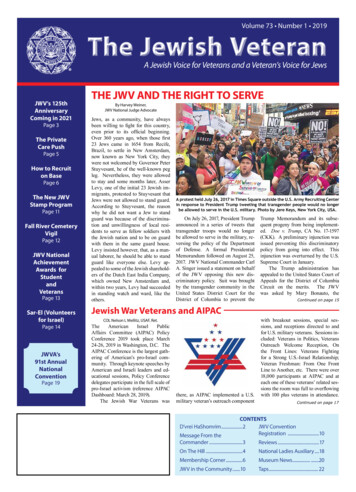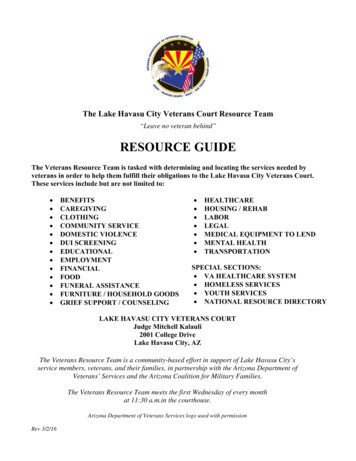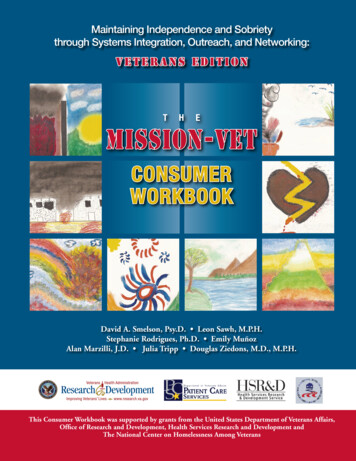
Transcription
Maintaining Independence and Sobrietythrough Systems Integration, Outreach, and Networking:V ete r a ns E d itionTHEMISSION-VETCONSUMERWORKBOOKDavid A. Smelson, Psy.D. Leon Sawh, M.P.H.Stephanie Rodrigues, Ph.D. Emily MuñozAlan Marzilli, J.D. Julia Tripp Douglas Ziedons, M.D., M.P.H.This Consumer Workbook was supported by grants from the United States Department of Veterans Affairs,Office of Research and Development, Health Services Research and Development andThe National Center on Homelessness Among Veterans
Maintaining Independence andSobriety through Systems Integration,Outreach, and Networking:Veterans EditionTHEMISSION-VETCONSUMERWORKBOOKDavid A. Smelson, Psy.D.Leon Sawh, M.P.H.Stephanie Rodrigues, Ph.D.Emily Clark MuñozAlan Marzilli, J.D.Julia TrippDouglas Ziedons, M.D., M.P.H.This Consumer Workbook was supported by grantsfrom the United States Department of Veterans Affairs,Office of Research and Development,Health Services Research and Development andThe National Center on Homelessness Among Veterans
Table of ContentsAcknowledgements.5Dedication.6Getting Started.7Introduction to Part 1.10Section A. Self-Guided Exercises.12Exercise 1. Relapse Prevention Plan. .12Relapse Prevention Plan Worksheet (sample).14Relapse Prevention Plan Worksheet.16Exercise 2. Preventing and Coping with Stress. .18Stress Worksheet (sample).19Stress Worksheet.21Exercise 3. “PICBA,” A Tool for Problem Solving.22PICBA Worksheet (sample).23PICBA Worksheet.28Exercise 4. Moving through the Fear.32Moving through the Fear Worksheet (sample).33Moving through the Fear Worksheet.36Exercise 5. Creating the Life that You Want.38The Life You Want Worksheet (sample).39The Life You Want Worksheet.43Exercise 6. Employment/Education Planning.46Employment/Education Planning.46Supported Employment Worksheet (sample).47Supported Employment Worksheet.49Campus Resource Assessment (example).51Campus Resource Assessment.54Exercise 7. Coping with Trauma-Related Issues.57Symptoms of PTSD.58Available Treatments.60Traumatic Stress in Female Veterans.61Managing Alcohol, Medication, and Drug Use.62Five Countdown Example.64Tips for Relaxation.65Section B. Checklists.67Checklist 1. Sources of Stress.68Checklist 2. Handling Stress.69Checklist 3. Medication Side Effects. .71Section C. Dual Recovery Therapy: Tools and Readings.731. Onset of Problems. .75My Timelines Worksheet (sample).76My Timelines Worksheet.772. Life Problem Areas.78Personal Life Problem Areas Worksheet (sample).79Personal Life Problem Areas Worksheet.802MISSION-VET Consumer Workbook
3. Motivation, Confidence, and Readiness to Change. .81Worksheet: Importance, Confidence, Readiness Ruler.824. Developing a Personal Recovery Plan. .83Personal Recovery Plan (example).84Personal Recovery Plan Worksheet.855. Decisional Balance. .86Should I Stay the Same or Change my Behavior? (sample).87Should I Stay the Same or Change my Behavior? Worksheet.886. Developing Strong Communication Skills. .89Elements of Good Communication.90Elements of Poor Communication.917. Orientation to 12-Step Programs. .92Alcoholics and Narcotics Anonymous (AA/NA).938. Anger Management.96Anger Management Worksheet.979. Relapse Prevention.98Warning Signs for Relapse.99Safe Coping Strategies to Try.100Dual Recovery Therapy Change Plan (sample).101Dual Recovery Therapy Change Plan Worksheet.10310. Relationship-Related Triggers. .105Relationship-Related Triggers Worksheet (sample).106Relationship-Related Triggers Worksheet.10811. Changing Unhealthy Thinking Patterns.110Types of Unhealthy Thinking. 111Identifying “Stinking Thinking” Worksheet (sample). 112Identifying “Stinking Thinking” Worksheet. 114Combating “Stinking Thinking” (sample). 116Combating “Stinking Thinking” Worksheet. 118Practicing New Ways of Thinking Worksheet (sample). 119Practicing New Ways of Thinking Worksheet.12012. Changing Irrational Beliefs.12110 Popular Irrational Beliefs.122Personal Irrational Beliefs Worksheet (sample).123Personal Irrational Beliefs Worksheet.12413. Scheduling Activities in Early Recovery.125Scheduling Activities in Early Recovery Worksheet (sample).126Scheduling Activities in Early Recovery Worksheet.127Introduction to Part 2.131Section A. Sustaining Recovery.1321. Understanding Mental Illnesses.133Depression.134Bipolar Disorder.134Generalized Anxiety Disorder (GAD).135Panic Disorder.135Social Phobia and other Phobias.1353MISSION-VET Consumer Workbook
Obsessive-Compulsive Disorder (OCD).135Post-Traumatic Stress Disorder (PTSD).136Borderline Personality Disorder.137Schizophrenia.137Traumatic Brain Injury (TBI).138Suicidal Feelings.1382. Coping Skills.139Planning Ahead.139Building Self-esteem.140Relaxation Skills.141Anger Management Skills.1443. Preventing Relapse.145Being Aware of the Danger.145Identifying your Triggers.145Finding Meaningful Activities.147Leading a Healthy Lifestyle.148What to Avoid in order to Sustain Recovery.1504. Medication Management. .153Understanding Medications.153Using Medications Wisely.160Talking with Your Doctor.1615. Using the Internet for Information about Recovery.1626. Reading List for Recovery.163Substance Abuse.163Mental Health.163Section B. Community Living.1661. Advocating for Yourself.1672. Money Management.169Budgeting.169Money Saving Tips.169Banking.170Using Credit Wisely.1703. Personal Hygiene.1714. Safer Sex.1725. Crime Prevention.175Apartment Safety.175Building Community.175Safety at the Door.176Preventing Fraud.176Street Safety.176Protect Your Belongings.176Public Transit Safety.177Interacting with Law Enforcement.177As You Return to the Community.178About the Authors.1794MISSION-VET Consumer Workbook
AcknowledgementsThis Maintaining Independence and Sobriety through Systems Integration, Outreachand Networking (MISSION) Consumer Workbook: Veteran’s Edition (MISSION-VET)is a publication supported by grants from the United States Department of VeteransAffairs [VA], Office of Research and Development [ORD], Health Services Research andDevelopment [HSR&D], and National Center on Homelessness Among Veterans. Theoriginal MISSION treatment studies and manual fidelity projects were supported by Grant# IIR 120-145 from VA HSR&D and Grant # TI16576 funded by the Center for Substance AbuseTreatment (CSAT), Substance Abuse and Mental Health Services Administration (SAMHSA),United States Department of Health and Human Services (HHS).We acknowledge the valuable feedback we received on the first edition of the MISSIONConsumer Workbook (Smelson, et al, 2007) from Pat Corrigan, Moe Armstrong, MiklosLosonczy, Sarah Guzofski, Manny Guantez, and Chris Barton. With appreciation, we alsothank our original MISSION treatment team, which included Bradley Sussner, Ph.D., MarkBenson, M.S.W., Chandra Mustafa, B.S.W., Louise Romalis, B.A., C.S.W., Mike Somers,Stephen White, Hamilton Cook, and Ray Gaines. Additionally, we thank our currentMISSION-VET team which includes David Kalman, Ph.D., Marsha Ellison, Ph.D., LisaNajavits, Ph.D., Elizabeth Aaker, Jennifer Vessella, Mandy Lennox, Kathryn O’Connor,James Taggart, Charles Delaney, David Goldstein, and Margaret Wiinikainen.We are grateful to the following Veterans who, representative of their continuingcommitment to go above and beyond the call of duty, also allowed us to publish theirartwork in this Workbook and in the accompanying Treatment Manual: Giovanni Roman,Chad Bowden, Bobby Moore, Steven Soucy, Brian Jester, Giles Fisher, and Joseph Johnson.We also acknowledge the efforts of Robin Gilmartin, L.C.S.W., Evie Lindemann, LMFT,ATR-BC, Nicole Pipitone, and Kim Starr, from the VA Connecticut Healthcare System.Without them, obtaining this artwork would not have been possible.Additionally, we wish to thank the leadership of VISN 1 and the Edith Nourse RogersMemorial VA Medical Center for their commitment to improving the lives of homelessVeterans. We also acknowledge the support, advice, and guidance we received from VA’sOffice of Research and Development, Health Services Research and Development Service,and National Center on Homelessness Among Veterans.Finally, we hope that you find this Workbook to be a useful resource as you move forwardto achieve your personal treatment and recovery goals. For questions regarding the use ofthe MISSION-VET Consumer Workbook, please contact your MISSION-VET Peer SupportSpecialist.David A. Smelson, Psy.D.Edith Nourse Rogers Memorial Veterans Hospital (Bedford VA)VA New England Health Care System (VISN 1)200 Springs Road Bedford, MA 017305MISSION-VET Consumer Workbook
The following institutions are affiliated with and participated in the writing of the MISSIONConsumer Workbook: Veterans Edition: United States Department of Veterans Affairs (VA) National Center on Homelessness Among Veterans Office of Research and Development (ORD) Health Services Research and Development Service (HSR&D) Edith Nourse Rogers Memorial Veterans Hospital (Bedford VA) Center for Health Quality, Outcomes and Economic Research (CHQOER) VA New England Healthcare System (VISN 1) VA Healthcare VISN 4 University of Massachusetts Medical School Department of Psychiatry Commonwealth MedicineDedication:To our Veterans: we salute you—who, with the same strength and couragethat marked your military service, are allowing us to stand by you andfight with you for the life you want.To VA and Community Service Providers: thank you for your tireless workon behalf of currently and formerly homeless Veterans with mental healthand substance abuse problems. You help them believe again that “nosoldier is left behind.”This workbook is dedicated to you.6MISSION-VET Consumer Workbook
Getting StartedYou have chosen, with many others, to walka path that leads to recovery. Each Veteran’spath is similar to the paths others havewalked, but because we are individuals, each pathis also distinctly different in certain ways. We havedifferent obstacles to overcome, different strengthsand weaknesses, different resources we can drawon, different memories, and different goals. Youridea of what “recovery” means may be differentfrom another Veteran’s.Where are you now? Where do you want togo? How will you get there? What’s in the way,and how willyou overcome it?What do you havegoing for you,and how will youuse it to your bestadvantage?This workbookwill help youwalk your path. Itcontains exercisesthat will help youin many ways: for example, to name and conqueradversaries within and without, to face yourfears, to think through your options in difficultsituations, and to realize what can cause relapseand what can help you avoid “slips.” There areno right answers. Your answers are your answersand no one else’s. Hearing others who are alsocourageously exploring what is true for them isimportant, though–hearing them can often helpyou hear yourself.The workbook is divided into two parts. Part 1,Section A, includes seven exercises that you canuse while you’re receiving MISSION-VET servicesto help strengthen and solidify the recovery toolsyou’re developing. Section B consists of threechecklists that are simple tools designed to helpyou in your recovery. Part 1, Section C, containsthe Dual Recovery Therapy Tools and Readings.These exercises and checklists are invaluabletools to facilitate your recovery. You shouldexpect to meet with your MISSION-VET PeerSupport Specialist once a week for a “check-insession” regarding the exercises and materialsin this Workbook that you will be doing onyour own. Please feel free to ask for additionaltime with your MISSION-VET Peer SupportSpecialist, if needed, regarding the materials thatyou will be completing as part of the exercises.Furthermore, please feel free to bring thesematerials with your MISSION-VET Case Manager,other treatment providers, or in sessions, asthey are personal to your recovery and meant tofacilitate the process.Part 2, “Readings and Reflections,” is intendedto help you prepare for your transition andadjustment back into the community. It includesuseful perspectives about recovery and helpfuladvice for making it on your own. The materialalso poses a number of questions that are meantfor you to reflect upon–whether in quiet times,talking with others, or by writing in a journal.You should expect to discuss specific readingswith your case manager as you prepare totransition or adjust to the community. Pleasealso feel free to bringup any thoughts orconcerns related tothe readings withyour MISSIONVET Peer SupportSpecialist, yourMISSION-VET CaseManager or otherVA and communitycase managers/careproviders, or withyour peers who arealso facing (or have faced) similar challenges. Ifthe amount of material seems overwhelming,7MISSION-VET Consumer Workbook
don’t worry–your assigned MISSION-VET PeerSupport Specialist will help you complete anddigest the materials.offer hope through the journey of recovery. Putit in your ruck, keep your courage up, and keepwalking. Good luck!This book was written for you by others whocare to assist you in developing new skills and to8MISSION-VET Consumer Workbook
MISSION-VETCONSUMERWORKBOOKPART 1Exercises and Checklists
Introduction to Part 1You are participating in MISSION-VETbecause you want to get the most outof your recovery from co-occurringpsychological and substance abuse problems,homelessness, unemployment, and/or traumarelated issues. Often times, while you areundergoing structured treatment for psychologicaland substance abuse problems, your life is closelycontrolled. Activities are scheduled; you’rescreened for drugs and alcohol, and there are otherexpectations.MISSION-VET adds another dimension toyour recovery efforts by serving as a bridge, bothwhile you’re in structured treatment and after youleave and enter the community. MISSION-VETprovides integrated treatment–meaning that itaddresses your psychological and substance abuseproblems together and recognizes the relationshipbetween the two. However, you need to help yourMISSION-VET Case Manager and Peer SupportSpecialist by sharing your thoughts and feelingsso they can help you look inside and identifywhat might be causing some of your distress. Thissection of the workbook will help you do this.Part 1 contains exercises and checklists foryou to complete while you receive MISSIONVET services, and as you transition and adjust tocommunity living. You can also use them after youcomplete the program to reinforce the recoverytools you’ve developed. The first set of exercises, or “Self-GuidedExercises,” in Section A can be done on yourown as you grow more comfortable with yourfeelings about why you’ve gotten to where youare. Completing the exercises will help youstart planning some of the tasks necessary forrecovery. You may want to write about whatyou’ve learned in a personal journal or just keepnotes within your workbook and reflect back onyour experiences from time to time. However,you should expect your MISSION-VET PeerSupport Specialist to have a weekly “Check-InSession” to review your progress and help youdigest the materials. The checklists in Section B are simple andstraightforward tools that will help you identifyimportant issues so that you can address themyourself or talk to others about them. Again,you should expect your MISSION-VET PeerSupport Specialist to have a weekly “Check-InSession” to review your progress and answerany questions about the checklists. The second set of exercises in Section C, “DualRecovery Therapy: Tools and Readings,” willbe used in the Dual Recovery Therapy (DRT)sessions with your MISSION-VET case manager.To get the most out of the integrated treatmentapproach
Finally, we hope that you find this Workbook to be a useful resource as you move forward to achieve your personal treatment and recovery goals. For questions regarding the use of the MISSION-VET Consumer Workbook, please contact your MISSION-VET Peer Support Specialist. David A. Smelson, Psy.D.
